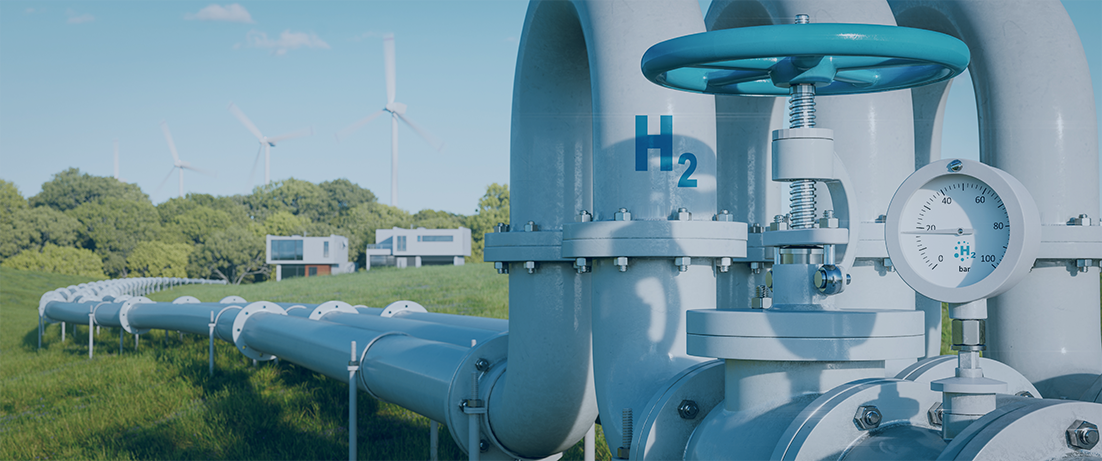
The importance of measuring dew point in hydrogen production
The development of a pan-European hydrogen distribution and supply infrastructure will be well advanced by 2030, if all goes to plan. The European Hydrogen Backbone (EHB) will create ‘five pan-European hydrogen supply and import corridors, connecting industrial clusters, ports, and hydrogen valleys to regions of abundant hydrogen supply’. The goal is to reduce carbon emissions while building a resilient and secure supply.
The EHB initiative is currently supported by 31 network operators – a number that is steadily growing – and covers a total of 28 EU and allied European countries. It is anticipated that a supply of 20.6 Mt of hydrogen will be available by 2030. This will be provided from a variety of sources, ranging from co-located (demand-side) electrolysis and centralized hydrogen production from captive renewable energy sources to large-scale blue hydrogen, pipeline and ship imports of hydrogen derivatives, such as ammonia and methanol. The five corridors are likely to reflect regional differences. For example, an interconnected network of offshore wind, large-scale hydrogen projects and ship imports based around the North Sea and northern Europe will be complemented by high-volume, low-cost production, and storage centers in southwestern Europe.
The expectation is that the project will reach maturity by 2040. By then, there will be a highly developed, extensive network, with the EHB securing over 50,000 km of pipelines, of which around 60 % will be repurposed from existing infrastructure. The intention is to be able to meet the projected 1,640TWh annual demand for hydrogen by 2040.
Hydrogen initiatives are not limited to Europe. In the USA, for example, the Bipartisan Infrastructure Law has recently been signed into the statute books and allocates $8 billion to developing the take-up of hydrogen and establishing ‘clean Hydrogen Hubs’ across the country. Similarly, Japan and South Korea – among many other countries – have set ambitious targets for electricity production using hydrogen and are actively developing hydrogen fuel cells for transport.
Hydrogen: production, technology, measurement and control
The rapidly growing level of interest in hydrogen as a green source of energy is also driving new developments in technologies used for production, transport, measurement, and control of the overall process.
One of the longstanding challenges has been the difficulty of transporting hydrogen from the source of production to the point of use. Although this will become less of an issue as dedicated pipelines and localized co-located renewable energy and electrolysis sites come on-stream, it will take time before we see meaningful change. Bear in mind that, at present, over 40 % of all hydrogen produced globally comes from centralized steam methane reforming plants; in the USA, this figure is around 90 %, so we have some way to go to change this model.
One solution that has been trialled successfully is to inject hydrogen into natural gas, at concentrations of between 5 % and 20 %, at the point of production. This can then be transported from where it is extracted to the point of use via existing pipelines. Transportation requires a combination of permeable membranes, to produce a level of purity up to 90 %, with pressure swing adsorption (PSA) units subsequently being used to increase purity to above 99 %.
Regardless of the method of hydrogen generation and transport, there are several key criteria that require monitoring and control if various production processes are to be managed safely and efficiently. Moisture and hydrogen dew point are two of the most important measurement parameters. This is because they are used as inputs to ensure that operation of gas drying systems is optimized, contamination is minimized, and risk of corrosion and damage to downstream equipment is eliminated.
Measuring hydrogen and moisture dew point
Our range of humidity and dew-point transmitters and analyzers is used throughout the hydrogen production chain, from steam methane reforming and hydrogen injection into natural gas streams, to pipeline transport, membrane separation, PSA and drying. In each case, products such as our Easidew Moisture Transmitter , QMA601 Trace Moisture Analyzer and CDP301 Portable Dew-Point Tester offer exceptional levels of accuracy, repeatability and reliability. Intrinsically safe versions of many of these products are also available, while the entire product range is backed by an extensive technical and application support service.
If you would like to learn more about our range of products for hydrogen generation and distribution, please visit: Hydrogen & Syngas
With almost 50 years’ experience in the development of innovative precision instruments, we are the application experts in dew-point and gas measurements for all hydrogen applications. Please contact our team today to discuss your requirements.
Found this article interesting? You may also like these:
How to Ensure the Safety and Gas Quality of Hydrogen Electrolyzers
What are the Best Analysis Techniques to Ensure Quality of Hydrogen in Production?
Sources:
Related Products
Dew-Point Transmitter - Michell Easidew EA2
Process Moisture Analyzer - Michell QMA601
Portable Dew-Point Tester – Michell CDP301
Want to see more information like this?
Sign up to one of our Industry newsletters and you’ll receive our most-recent related news and insights all directly to your inbox!
Sign Up